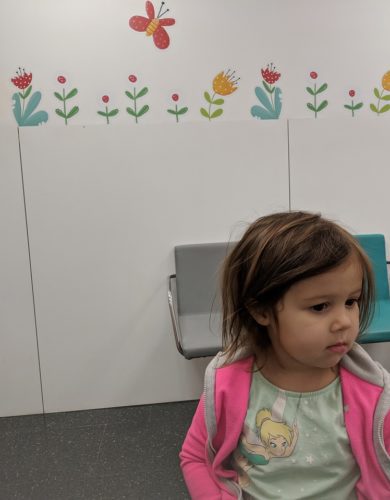During our second month living as expats in Madrid, we were faced with our first experience with socialized healthcare. When living in the States we often heard that socialized care meant long wait times, mediocre to bad doctors, and insufficient staff. I’m here to tell you that based on my experiences so far, that couldn’t be farther from the truth.
In the matter of two weeks I experienced first hand (on two occasions) what it was like to go to an “urgent care” physician along with a hospital visit with my two-year-old. I was given a small insight in order to compare it to my past experiences in the States.
Both times mentioned were fast, efficient, and I was offered excellent care. In addition, I didn’t have to worry about the out-of-pocket cost of an initial consultation, tests, x-rays, or medication.
It was the first time in my seven years of being a parent where I didn’t have to worry about taking sick leave at work, being blasted with a high hospital copay, or receiving an outrageously high bill at the end of the month.
My daughter Munroe and I ended up catching an extremely bad viral cold. She was placed on a nebulizer during the first week of her illness, but unfortunately it ended up turning into pneumonia. Her cough had gotten much worse and she ended up spiking a fever. In Madrid, you don’t have to wait to schedule an appointment with the doctor; you can immediately go to the hospital to receive care even if it is not considered an emergency.
I didn’t know what to expect, except for the fact that I did not speak enough Spanish to explain to the doctor what was wrong with my daughter. So before I took her I put a plan into place. I wrote down every symptom that she had, the medication that she was on, and how long she had been sick. I then took out my phone and entered everything that I had written into Google Translate and then proceeded to write the Spanish translation down on another piece of paper. I then got her dressed, grabbed the medication that she was on, grabbed the paper with the Spanish translations, and called an Uber for a ride to the hospital.

When we walked into the emergency area I handed the woman at the reception area my paper. She said “claro” and assisted me down a hallway to the pediatrics wing. Once there, I handed my paper to another woman who then took me to a room.
Let me repeat this: she BROUGHT ME TO A ROOM. There was no waiting in a waiting room.
Immediately a Spanish AND an English speaking doctor entered the room along with a nurse. They took her vitals and they spoke to me (one in Spanish and one in English) about what they were going to be doing. We were then escorted shortly after by the radiologist to have x-rays done. We waited for less than five minutes before we were called in. We were then brought back to our initial room where we waited for about 15-20 minutes for the results from the x-ray to find out that she had the beginning stages of pneumonia.
Not only were the doctors and medical staff extremely efficient and thorough, I waited less time at a hospital visit in Madrid than a regular doctor’s office visit in the States. And it was 100% covered. As a parent, this was a huge sense of relief. Yes, I pay taxes to help with the socialized healthcare, but it is so much easier and cheaper than what I would have to pay out-of-pocket even with insurance in the United States. Now, this is my experience with Spanish healthcare which is ranked among the best in the world. I realize that it might be different with other socialist governments, however, I’d like to share some information about what to expect when dealing with healthcare overseas no matter where you are at.
Social Security
In order to receive socialized healthcare in countries like Spain, you will need to file for your Social Security card. This is a pretty laborious process so make sure that you contact someone (whether that be your employer, family member, or friend) that can help you with this process. Also do NOT wait until you are sick to do this. It takes time so do it as soon as you arrive to your destination and have signed a lease on a home or apartment to prove residency. IF you do not apply for social security you will have to pay out of pocket. This still isn’t as expensive as an out-of-pocket hospital expense in the US, but expect it to be around $300 give or take.
Although convenient, Socialized healthcare choice is limited.
This is especially the case for someone who is looking for an English speaking doctor. Because hospitals take regular walkins, it might be best to go to the hospital where more doctors are present that are bilingual. Otherwise, try not to be too picky or ask for recommendations when possible.
Have a plan in place.
Write down or take the time to learn key words about common cold/flu terms that can be used when in a country that speaks a language other than your own. This is helpful when trying to communicate. Also write down any and all prescriptions and dosages of medications that you regularly take. Do the same for any allergies that you or your children may have. Keep all of this and your social security card together so that you have access to it every time you need to go to the doctor or pharmacy.
Some common and important phrases to know in Spanish are:
- Accident: Accidente
- Emergency: Emergencia/Urgencia
- I need an ambulance: Necesito una ambulancia
- I need a doctor: Necesito un medico
- Heart attack: Ataque cardiaco/Infarto
- Stroke: El accidente vascular cerebral
- I need a dentist: Necesito un dentista
You can still receive private insurance.
You might think, “why?” Private isn’t necessarily better than public healthcare especially in Spain but it DOES give you more options especially with specialists. We have private insurance provided by our employer and my husband uses it so that he could have the choice of what neurologist to see for his epilepsy. For everything else, we use public healthcare.
Emergencies
It is important when moving overseas (especially with children) that everyone know that the emergency number is NOT 911. That is ONLY linked to the United States. The emergency EU code is 112.











This is a great post. I can’t wait to hear more. I am an American physician and thinking of brining my family to live in Spain. Do you ever run into expat American doctors? What else have you learned about healthcare in Spain? Thanks again!
I am also looking to move with my husband and two daughters to Spain. We lived in Germany before but my kids don’t remember much. What job sites do you recommend we use?